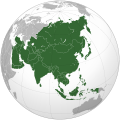History
Some microcontinents are fragments of Gondwana or other ancient cratonic continents; examples include Madagascar; the northern Mascarene Plateau, which includes the Seychelles Microcontinent; and the island of Timor. [5] Other islands, such as several in the Caribbean Sea, are composed largely of granitic rock as well, but all continents contain both granitic and basaltic crust, and there is no clear dividing line between islands and microcontinents under such a definition. The Kerguelen Plateau is a large igneous province formed by a volcanic hotspot; however, it was associated with the breakup of Gondwana and was for a time above water, so it is considered a microcontinent, though not a continental fragment. [6] [7] Other hotspot islands such as the Hawaiian Islands and Iceland are considered neither microcontinents nor continental fragments. Not all islands can be considered microcontinents: Borneo, the British Isles, Newfoundland, and Sri Lanka, for example, are each within the continental shelf of an adjacent continent, separated from the mainland by inland seas flooding its margins. [8]
Several islands in the eastern Indonesian Archipelago are considered continental fragments, although this designation is controversial. The archipelago is home to numerous microcontinents with complex geology and tectonics. This makes it complicated to classify landmasses and determine causation for the formation of the landmass. [9] These include southern Bacan, Banggai-Sulu Islands (Sulawesi), the Buru-Seram-Ambon complex (Maluku), Obi, Sumba, and Timor (Nusa Tenggara). [10]
This page is based on this
Wikipedia article Text is available under the
CC BY-SA 4.0 license; additional terms may apply.
Images, videos and audio are available under their respective licenses.











